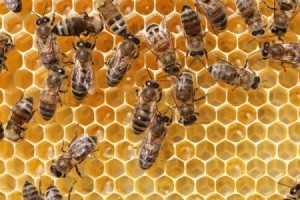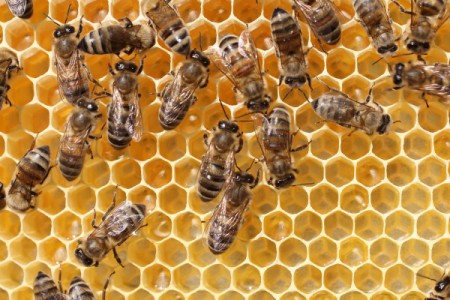
 Honeybees, as we know them today, have been pollinating flowers for more than 60 million years. Without these remarkable insects, as many as two-thirds of the plant species in the world and roughly a third of the average U.S. diet would simply disappear.
Honeybees, as we know them today, have been pollinating flowers for more than 60 million years. Without these remarkable insects, as many as two-thirds of the plant species in the world and roughly a third of the average U.S. diet would simply disappear.

There are three types of bees in a honeybee hive: one queen, the male drones, and lots and lots of female worker bees. The queen's sole job is to ensure the continuance of the hive. She lives her life as a reproductive machine, laying up to 2000 eggs a day, nearly three quarters of a million of them over her two year lifespan. The male drone's job is to hatch, eat, and wait around to mate with the queen. Mating is sexual suicide for the drones, as it leaves them with a mortal wound and causes their immediate death. Finally, there are the female worker bees, which make up 99% of the colony's population. They do everything else: take care of the queen, raise the young, build the honeycombs, gather the nectar, produce the honey, and guard the hive. (If you've ever been stung by a bee on the wing, it was almost certainly a female worker bee.) As the phrase suggests, the worker bees are truly busy-as-a-bee from the moment they emerge until six weeks later, when their little tired bodies and tattered wings literally die of exhaustion.
Honeybees make honey from nectar, the sugar-rich liquid, produced by flowering plants. They use their long, straw-like tongues (proboscis) to suck nectar out of flowers and into their two stomachs. A small amount of the nectar goes into the bee's regular stomach to provide them with energy. The bulk of the nectar goes into their second stomach (crop), also known as the honey stomach. This honey stomach is where the nectar is stored until the bee gets back to the hive. Depending on the availability of blooms, a honeybee may need to visit as many as 1,500 flowers in order to fill their honey stomach to capacity.
Once their honey stomachs are full, the bees return to the hive and deliver the nectar to other worker bees, which siphon off the nectar from the honeybees stomach through their mouths. These bees then chew the nectar for several minutes, adding enzymes to the nectar that make it more digestible and protect it from spoiling. After the nectar is sufficiently chewed, the bees spread the nectar onto the honeycombs for drying. The bees speed up the drying process by continuously fanning the nectar with their wings. This causes most of the remaining water to evaporate and thickens the nectar to the consistency of honey. The bees then seal off the cells of the honeycombs with wax excreted by special glands located on the bee's abdomen. The honey remains sealed in the combs until it is collected by the bee keepers, or the colony uses it for food. Depending on the size of the colony, the bees will consume between 120 and 200 pounds of honey per year.
The decline of the honeybee population in the United States and worldwide could have far-reaching implications for food supply. While we don't yet know what is causing Colony Collapse Disorder, scientists and bee keeper alike do know that forces like habitat destruction, invasive species, the overuse of pesticides, global warming, and other environmental stresses create risks to bees.
To find out how you can help save honeybees, visit the Honeybee Conservatory's website.
Add your voice! Click below to comment. ThriftyFun is powered by your wisdom!
WOW !!!!! This is a VERY informative piece on Honeybees. Thank you very much EllenB, I liked it a lot and learned a couple things too.
Add your voice! Click below to comment. ThriftyFun is powered by your wisdom!